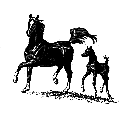Additional site navigation is at the bottom of each page.
MORE: EPM, Equine Protozoal Myeloencephalitis...
MORE ON EPM
This week we will continue our discussion of Equine Protozoal Myeloencephalitis (EPM). As always, we are thankful the name can be abbreviated into just three letters.
Last week we discussed how the organism causing the disease spreads to the horse. The only way to prevent the spread of the disease is to either control the opossums and the birds, or move! Protecting the grain source is the easiest, and doing so will reduce the bird population as well. A few cats may help with the birds and a live trap will help with the ‘possums. Some of these recommendations may sound like they are made tongue-in-cheek, but within a couple of years they will be taken very seriously. With the organisms’ ability to produce millions of offspring within each bird and opossum, and these offspring being able to live up to a year outside their host after being passed, the potential for spread to both ‘possums and horses is tremendous.
Only a small percentage of horses that contact the organisms go on to develop symptoms of the disease. Random blood sampling of horses in Ohio and Kentucky found 55% of the horses had a positive titer for the organism. This indicates these horses had ingested the sarcocysts, but they were not showing any signs of the disease. When a horse is presented to us with a nonspecific lameness, a lameness without soreness, a wasting of the heavy muscle area of the back or legs, lack of coordination or any of the neurological signs (including sensation loss affecting various parts of the face), we include EPM in the list of possible diagnoses. At that time we take a blood test and submit it to the lab to be tested for EPM.
If they report the sample is negative, we can eliminate EPM as the problem. If the test is reported as positive, a spinal tap must be done to confirm the organism is present in the spine. This is a little more involved and involves a little more risk, but must be done. It is only with a positive spinal fluid test that we can be absolutely certain that EPM is the cause of the above condition.
If the patient is diagnosed with EPM, treatment must be started immediately. Some of the more seriously infected horses will be deteriorating so fast a delay in treatment would result in the loss of the horse. Most will take a week or two to respond to treatment, if they are going to respond at all. There is about a 60 % cure rate, with “cured” being defined as when the spinal fluid test is negative for the organism. Better results come with earlier and more aggressive treatment.
The current treatment consists of a combination of antibiotics and anti-inflammatories given orally each day. Treatment is continued until the spinal fluid tests negative. This test is taken sometime after three months of treatment, but the average treatment lasts four months. If the test is still positive, the organism is still alive and well within the spinal tract. Treatment is continued, and with the long term use of the antibiotics, certain vitamins and blood builders must be added to counteract their effect on the horse’s body. There is considerable expense involved in the treatment of the EPM infected horse.
EPM is a disease that will be with us for some time to come. The above is the current treatment. There is a great deal of research being done now, and with it is the hope for a breakthrough, for a more successful treatment, and eventually for a way to break the life cycle. There will be a great deal more discussion about this persistent and challenging disease in the future.
CLICK BELOW TO DISPLAY A PRINTER-FRIENDLY COPY OF THIS ARTICLE
Select "Open this file from its current location," if you just want to print it out,
it will open in a simple word processing application, select the print button.
(unless you want to save this article in your computer's memory)

 more_on_EPM2.rtf
more_on_EPM2.rtf